'Bommai Golu' | A unique tradition of displaying dolls during Dussehra
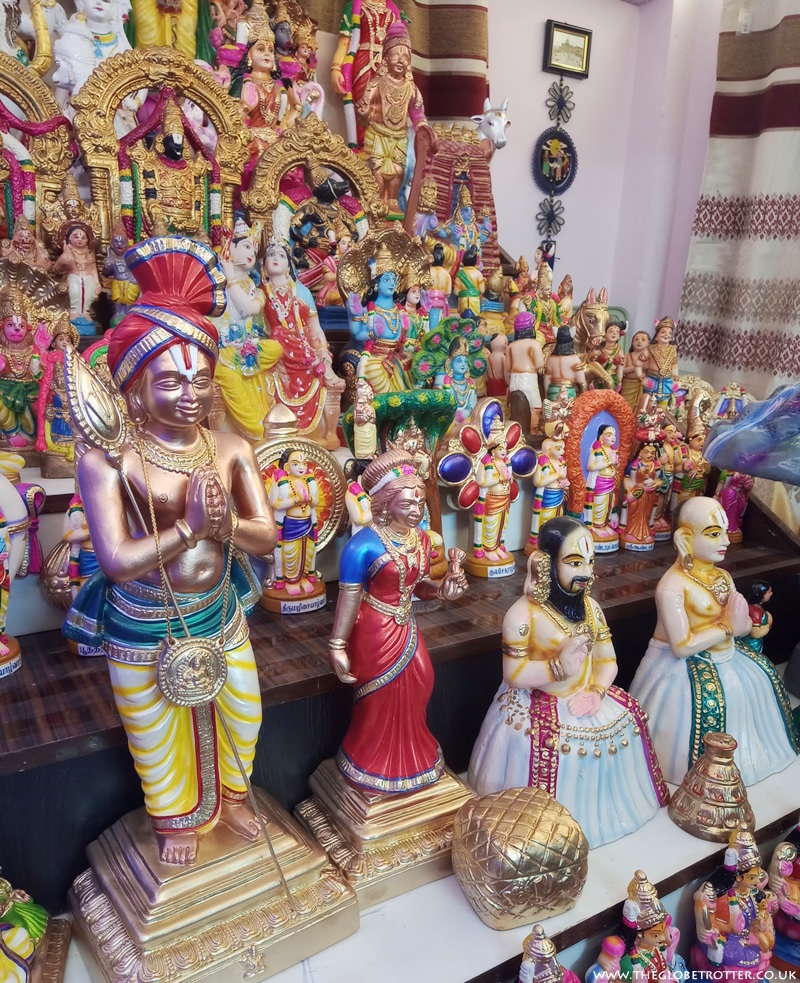
This Dussehra I was in India and happened to visit the homes of several friends and relatives during the festive season. Dussehra is also called as Vijayadashami or Navaratri or Dasara or Durga Puja depending on the Indian state you are in but in all cases the festival is essentially a celebration of goodness over evil. People celebrate the festival in their unique traditional way based on their local culture.
In the northern states, one of the key aspects of Dussehra is the Ramlila performance which is an enactment of stories from the Ramayana. Artists perform at fairs across the state and these plays draw audiences in the thousands. In the western state of Gujarat, Dandiya Raas and Garba (traditional folk dances) are the highlight of Dussehra with performance arts on all days of the festival. Dressed in colourful traditional dresses and with coordinated movements, people dance in concentric circles to music (mostly live orchestra).
In West Bengal, the festival takes on the form of Durga Puja. There is dancing, music and 'pandals' are erected at several venues where clay sculptures/idols of Goddess Durga are worshipped.
In southern India, the celebrations take on different forms. In Karnataka, especially in Mysore, temples are decked up and Dussehra processions are taken out with dance groups, tableaux, music bands and more. In Telangana, one of the notable traditions of Dussehra is the Bathukamma which is a creative and beautiful decoration of flowers in a stack, in seven concentric layers. The floral celebration also includes traditional dancing by the womenfolk who are dressed in their best traditional clothes and jewels.
Bathukamma

In Tamil Nadu, in addition to decoration of temples and dance performances, one other notable part of the festivities is the Bommai Golu display. You will find this in the states of Andhra Pradesh and Karnataka as well, where they are called Bommala Koluvu and Gombe Habba respectively.
What is Bommai Golu?
Bommai Golu (also called Golu or Kolu) is the artistic display of traditional dolls and idols during Dussehra. An assortment of dolls and figurines are arranged on a step-like wooden frame with the placement of the dolls representing the spiritual progression of humans.

The 'steps' can vary in number from 1 to 11 depending on the space one has available and the number of dolls one has but the steps have to be odd numbered - 1, 3, 5, 7, 9 or 11. These steps are usually made of wood or metal and are dismantlable. They are covered and decorated with plain cloth or sarees and then the dolls are placed on them.

The arrangement of the dolls and idols also follows a pattern. If you were keeping a Golu with 9 steps then the first three steps on the top would feature Gods & Goddesses. The next three steps would include idols of saints, enlightened ones and other learned people. The bottom three steps would represent humans and their activities follwed by birds & animals.
Depending on the number of steps you have in your Golu and your collection of dolls, the allocation of steps to each set of dolls would obviously vary, but the hierarchy remains the same.

Generally, at least one new doll is added to the Golu collection each year. And often, the dolls on display are passed on from one generation to another. So, don't be surprised if you come across dolls that are over hundred years old!
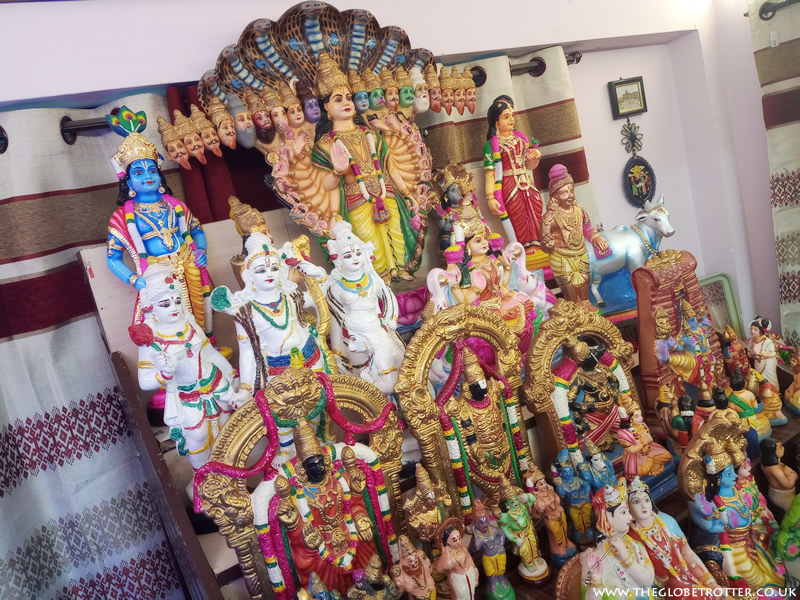
Most Golu arrangements have an idol of Goddess Durga in one form or the other. Some people keep a 'Kalasham' instead which is a traditional holy pot. It is decorated with mango leaves and holds a coconut and is viewed as a symbol of wisdom and abundance.

On the bottom most step of the Golu arrangement, you will usually find Marapachi Bommai.
Marapachi Bommai ('wooden dolls' in Tamil) are traditional dolls representing a couple and symbolising fertility and well-being. Traditionally, this pair of dolls was gifted to the bride by her parents to wish her a happy and prosperous married life. These dolls are also gifted by mothers to their daughters when they start their Golu arrangements and it is usually passed down the generations. Each year, the dolls are decorated with new dresses and enjoy a prominent placement in the Golu arrangement.

Another common doll that you will come across in most Golu arrangements is the Chettiyar and Chettichi Set. These bobble-headed dolls represent the business heritage of the Chettiyar community as well as happiness and prosperity. The Chettiyars were well-known for their family-run grocery business in which both the husband and wife took part. In a typical Golu setting, these dolls are placed along with fruits/vegetables and grains on one of the bottom two steps.
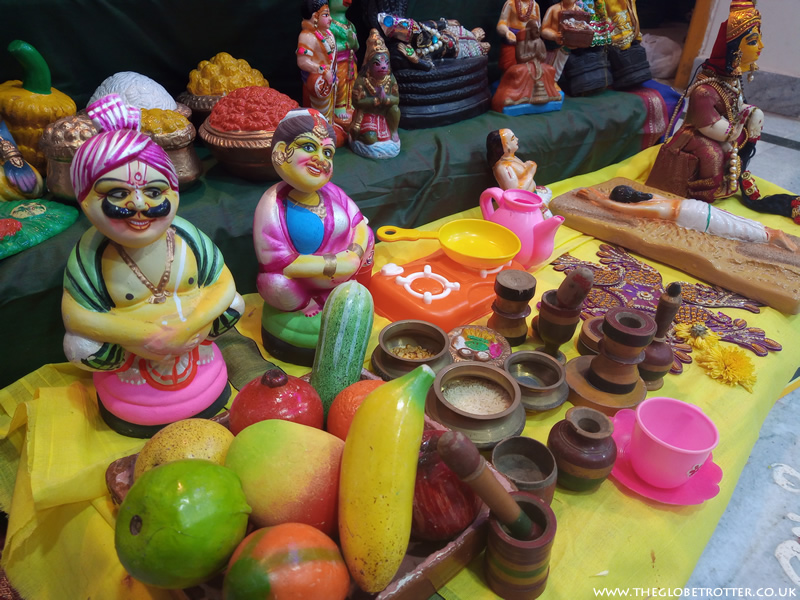
In the picture below, if you look at the middle step, you will see the 12 Alvars. The Alvars were Tamil poet-saints who were known for their devotion to Vishnu and went travelling from one town to another composing and singing beautiful poems in praise of the deity. The 12 Alvars came from different backgrounds and the most well-known were Periyalvar, Nammalvar and Andal (the only female Alvar and the foster daughter of Periyalvar). You will find these idols in the middle steps where the saints are placed.

Another popular Golu set is the Garuda Vahana Seva which depicts the Garuda Vahana procession undertaken during the Brahmotsavam. A beautifully decorated idol of Bhagwan Vishnu is taken around the temple atop Garuda, the Vahana of Vishnu. This type of Seva is performed in most Vishnu temples across India but the most popular one is the Seva at Tirumala during the Brahmorsavam days.
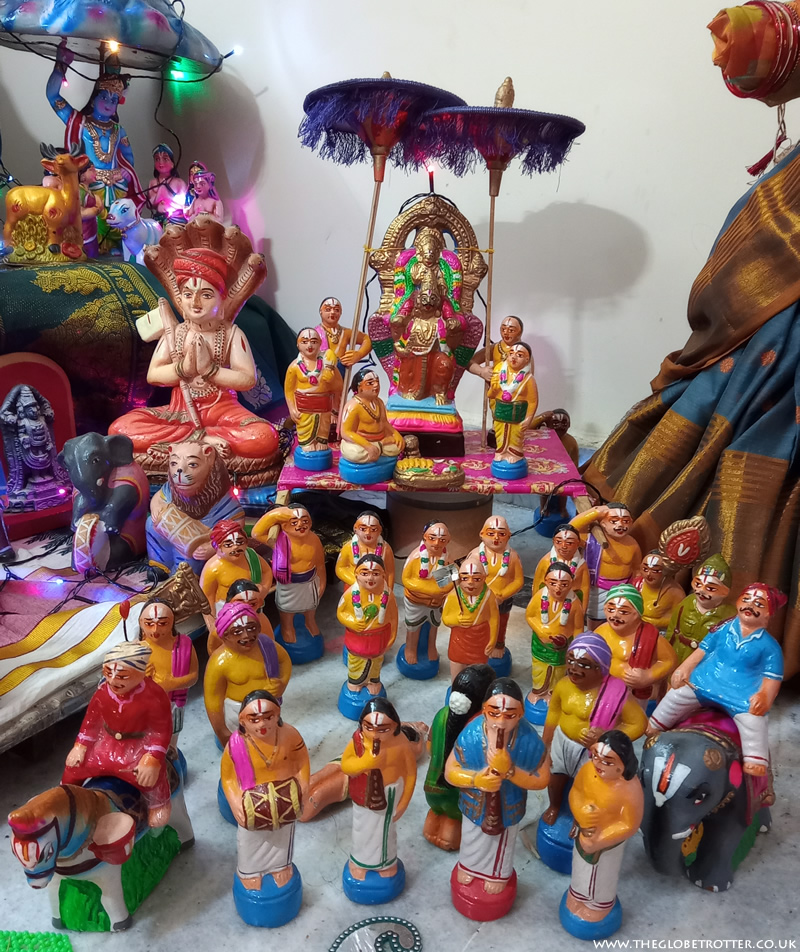
Each doll or sets of doll used in the Golu has a story to tell. It is a beautiful way to celebrate the stories of Ramayana, the Puranas, the Navdurgas and more.
The Golu arrangement is kept for 3-9 days and on the tenth day (the last day of the festival), the dolls are symbolically put to sleep marking the end of the year's Golu. The next day, the dolls are packed and stored and the Golu steps dismantled for next year’s use.



When the Golu arrangement is in place, women of the house invite other womenfolk and children (friends and neighbours) to their home. Pujas are performed, 'shlokas' are recited and 'Sundal' and sweets are served to the guests. 'Sundal' is a stir-fried dish made with boiled chickpeas, boiled peanuts or other boiled legumes. For each day of Golu, a different variety of Sundal is made and is distributed among near and dear. It is also customary to give betel leaves with areca nuts (vethalai pakku), along with haldi (turmeric), kumkum (vermilion powder), flowers & fruits to the women who visit.
My aunt, Shobha Sridharan, who lives in New Jersey, started the tradition of keeping Golu when her two sons asked her why they didn't do it. That was years back and since then it has been an annual tradition in their household. They ordered a 5-step dismantlable Golu step from a local Indian in New Jersey and their initial collection of traditional Golu dolls arrived all the way from Chennai. Their initial collection included staple Golu sets like Dasasvataram, Mahalakshmi Kalyanam etc. and since then their collection has been growing - mostly with items being gifted to them by friends and relatives. Now they have so many things to display that they are unable to put them all out every year - so they have started rotating through the collection and doing a selective display each year.
My aunt usually picks a Saturday within the 9 days of Dussehra to invite all their friends and from the time the doorbell starts ringing at around 4:00 pm, till the last guest arrives, it is usually close to midnight. It is a floating crowd but they get around 30 to 40 families visiting them on that single day.
My aunt's two sons participated a lot when they were in school, setting up their own corners in the Golu arrangement and exhibiting their creativity. Now they are all grown up but my aunt still enjoys setting up the Golu every year (see photo below). As she says, "Golu not only exposes kids to our traditions and culture, but also helps keep them socially connected with friends and family".
Sruthi, who was born and brought up in Chennai and now lives in Calgary (Canada) keenly celebrates each and every Indian festival as she believes that it keeps her family rooted to the Indian culture. She involves her children so that they understand what it is to be a part of the rich Indian culture and tradition.
Traditionally the Golu is setup on an Amavasya (new moon day) before Navaratri. But owing to the size of their Golu, she usually takes out the dolls on a new moon a month before the Navaratri. The Golu steps are built from scratch by her husband with wood. Then the steps are covered with decorative cloth. Marapachi dolls or wooden dolls are kept first on the steps followed by dolls of deities, Gurus in subsequent steps. They also keep dolls of birds, animals, stories, chettiar & chettichi. Most of Sruthi's dolls are passed on to her by her family and are generations old. Over the years she has added many small and big themes like, temple procession, Krishna, cricket, kids zoo, etc. as this is one of the best occasion to show their creativity as well. Kids who come home thoroughly enjoy the display.
Sruthi also loves the socialising aspect for which Navaratri is known. Unlike India, people are spread out in many communities where she lives in Canada and they otherwise don’t meet them very often owing to their lifestyles. Golu gives them the chance to meet up with friends and family.
On the 10th day of Vijayadashami is when they put the Marapachi dolls to sleep. It signifies that the festival has come to an end. The dolls are packed the day after and Sruthi bubble wraps the dolls and stores them in cardboard boxes until the next year.
Check out Sruthi's beautiful Golu below.
Golu is a great way to celebrate traditions as well as to bond with friends and family. It is also a chance to show off one's creativity via the Golu arrangement. And lastly it is also a festival that aims at supporting small, independent artisans who deserve recognition and support for their beautiful craft.
Do you have any Golu stories to share? Let me know via the comments box below.
Also, if you are interested in reading about other Indian festivals, then take a look at our article on the festival of Pongal.

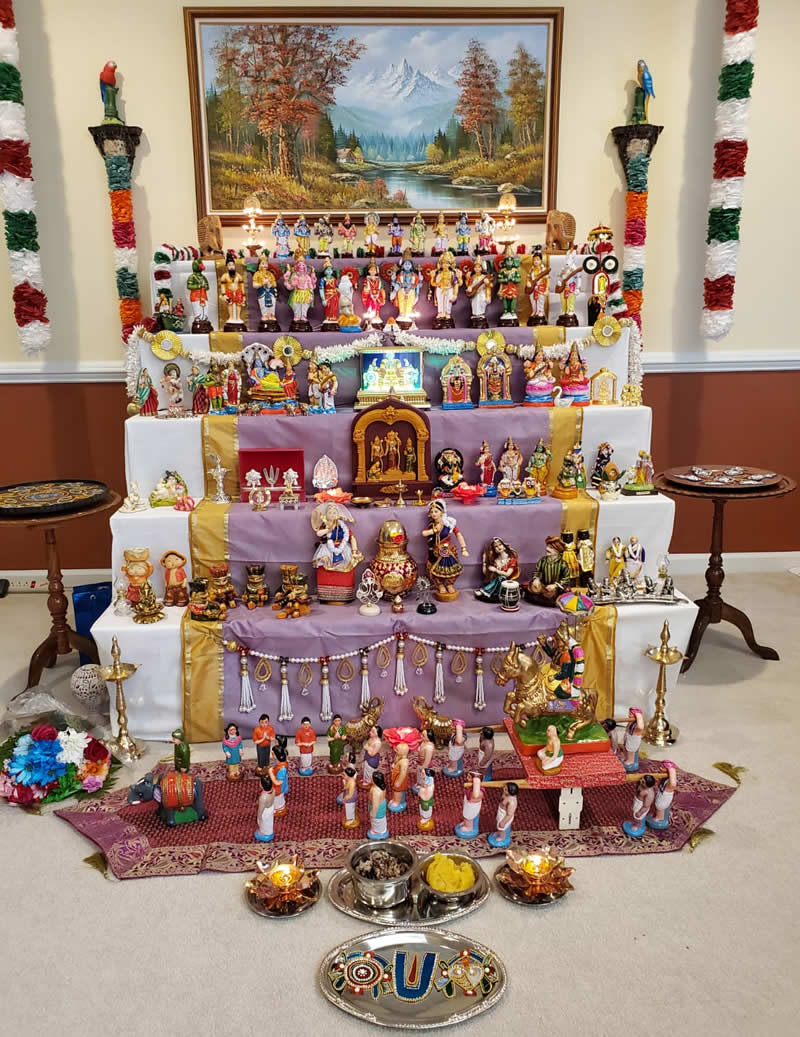

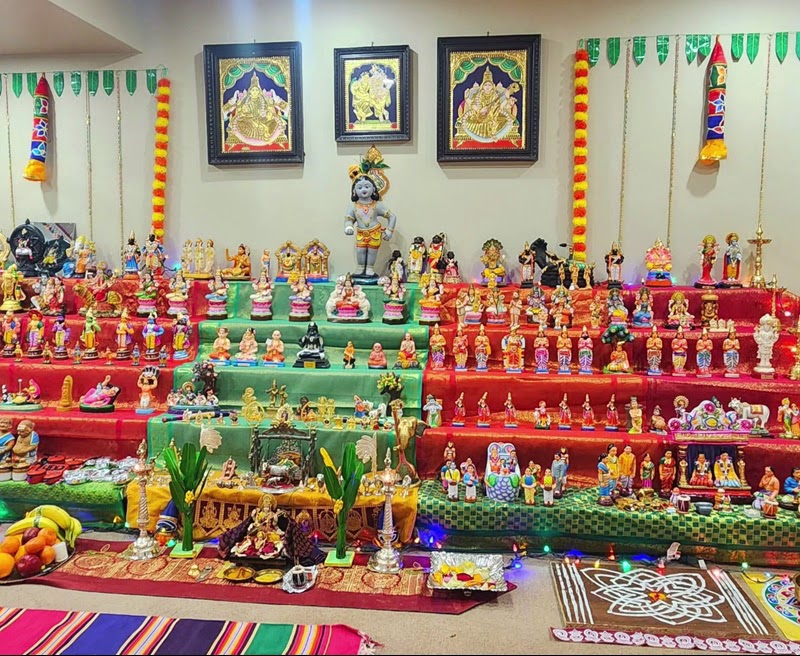

Excellent display..God Bless..
ReplyDeleteThank you.
DeleteWonderful explanation!
ReplyDeleteThank you :)
Delete